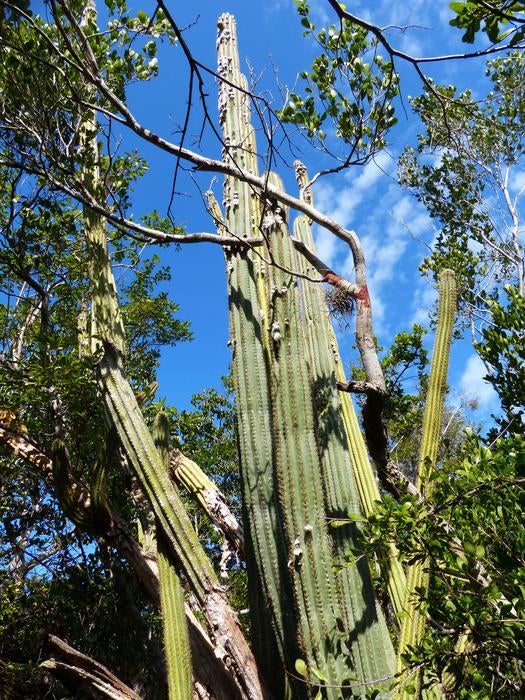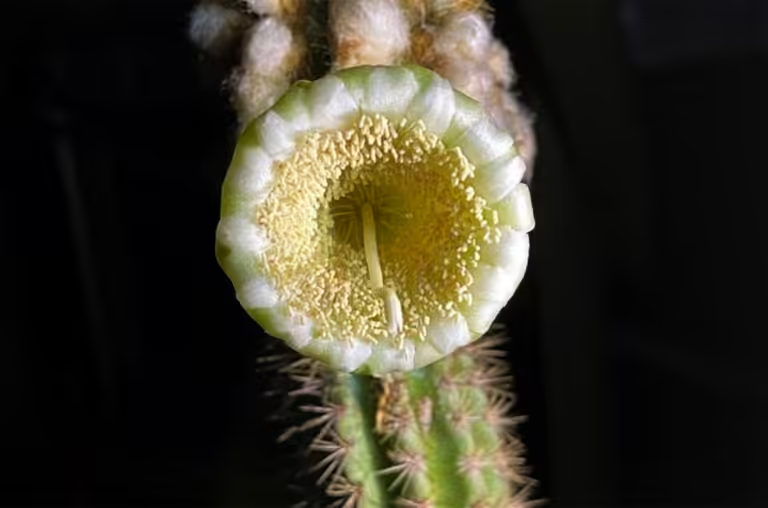Meet the first US species to go extinct due to rising sea levels
A tall cactus found only in Key Largo, Florida, is the first U.S. species to become extinct due to rising sea levels.

The Key Largo tree cactus was first discovered in a single location in the United States in 1992. Rising sea levels and more severe storms have since wiped out the population.
Courtesy of Susan Colterman
James Lange remembers the day he and a team of botanists and conservationists gathered on a rocky outcrop surrounded by mangroves in Key Largo, Florida. They had come to the country’s last remaining wild population of a rare cactus to face an inevitable fate. With rising sea levels bringing the Atlantic Ocean ever closer to the shriveled plants, the group made the difficult decision to remove the remaining green parts of the cactus and preserve them in a nursery, in the hope that they would one day return to the wild.
Three years later, a study published last week confirmed what Lange and others had long suspected: The decline of Key Largo’s arboreal cacti marks the first recorded instance of rising sea levels driving a native species to extinction in the United States. For Lange, a research botanist at Fairchild Tropical Botanical Garden in Coral Gables and co-author of the study, the decline of the arboreal cacti was a major blow. “It was part of what made the Keys special,” he said. “They’re just big, bold, beautiful plants.”
Tree cactus is an apt name for Pilosocereus millspaughii., Known for its towering white flowers that attract nectar-hungry bats and reddish-purple fruits that are eaten by birds and mammals, the cactus still grows scattered across a few Caribbean islands, but in North America it was limited to a thriving colony of 150 plants discovered in the Florida Keys in 1992. By 2021, only six sickly stems remained.
Support science journalism
If you enjoyed this article, please support our award-winning journalism. Subscribe. By purchasing a subscription, you help ensure a future of influential stories about the discoveries and ideas shaping the world today.
Scientists say this is an enormous loss because of what it means: Man-made global warming is no longer just endangering human society: it is eradicating the very species that make up the fabric of our natural world.

Key Largo Tree Cactus.
Courtesy of Susan Colterman
“It’s important to see this existential threat that everyone is aware of, the actual evidence that it’s happening, and to anticipate what’s to come,” Lange said. He remembers “everything looking terrible” as the ocean rapidly encroached on the plant community. “We knew there was no long-term hope for this population in this area,” he said. “There’s no shortage of plants in the Keys that are threatened by the same fate.”
Dozens of coastal species in the Florida Keys, from the endangered Big Pine Partridge Pea to the Jumping Thorn Apple, could be next to go extinct in one of the places most vulnerable to sea-level rise. And unlike the Key Largo cacti that are barely surviving elsewhere, some of these cacti are the last of their species.
“This is very worrying,” said Marcelo Aldon, a coastal ecologist at North Carolina State University. “Climate change is compounding all these factors and making these populations even more vulnerable.”
In 2015, Key Largo’s cactus species were stressed by a mass herbivory event, in which animals ate large amounts of the plants. (Researchers speculate that this may have been caused by a shortage of freshwater during tidal flooding, which led to thirsty wildlife, such as raccoons, nibbling on the stems.) The threat was compounded by the storm surge and damage caused by Hurricane Irma, as well as the repeated king tides that followed. Jennifer Posley, lead author of the new study, thinks this could be a “harbinger of how other low-lying coastal organisms may respond to climate change.”
But plants aren’t the only species facing looming extinction on a planet being reshaped by a warming climate. Ten years ago, the Center for Biological Diversity identified 233 federally protected species in 23 coastal states that were most at risk from rising sea levels. At the top of the list were the Key deer, loggerhead sea turtle, Delmarva Peninsula fox squirrel, western snowy plover, and Hawaiian monk seal. Today, restoration efforts have saved five of these threatened species from extinction, but with their respective habitats threatened by rising sea levels, their futures are increasingly in question.
Globally, climate change has already caused extinctions of a wide range of plants and animals, from the Australian rodent Bramble Cay melomys, the first mammal to be driven extinct by global warming, to the “functional extinction” of the elkhorn coral in the Keys and several species in German bogs. If emissions continue to grow at their current rate, some estimates suggest that roughly one-third of plant and animal species could become extinct by 2070.
Plant physiologist Louis Ziska feels the loss of any species due to climate change deeply, and the loss of Key Largo’s arboreal cactus in particular is all the more meaningful to Ziska, who vividly remembers admiring the spiny cactus during a visit to the Florida islands. “It’s a beautiful plant, and very moving,” Ziska says, “so to see it go there’s a sense of loss, almost mourning.”
This story begins: GristA nonprofit media organization covering climate, justice and solutions.

